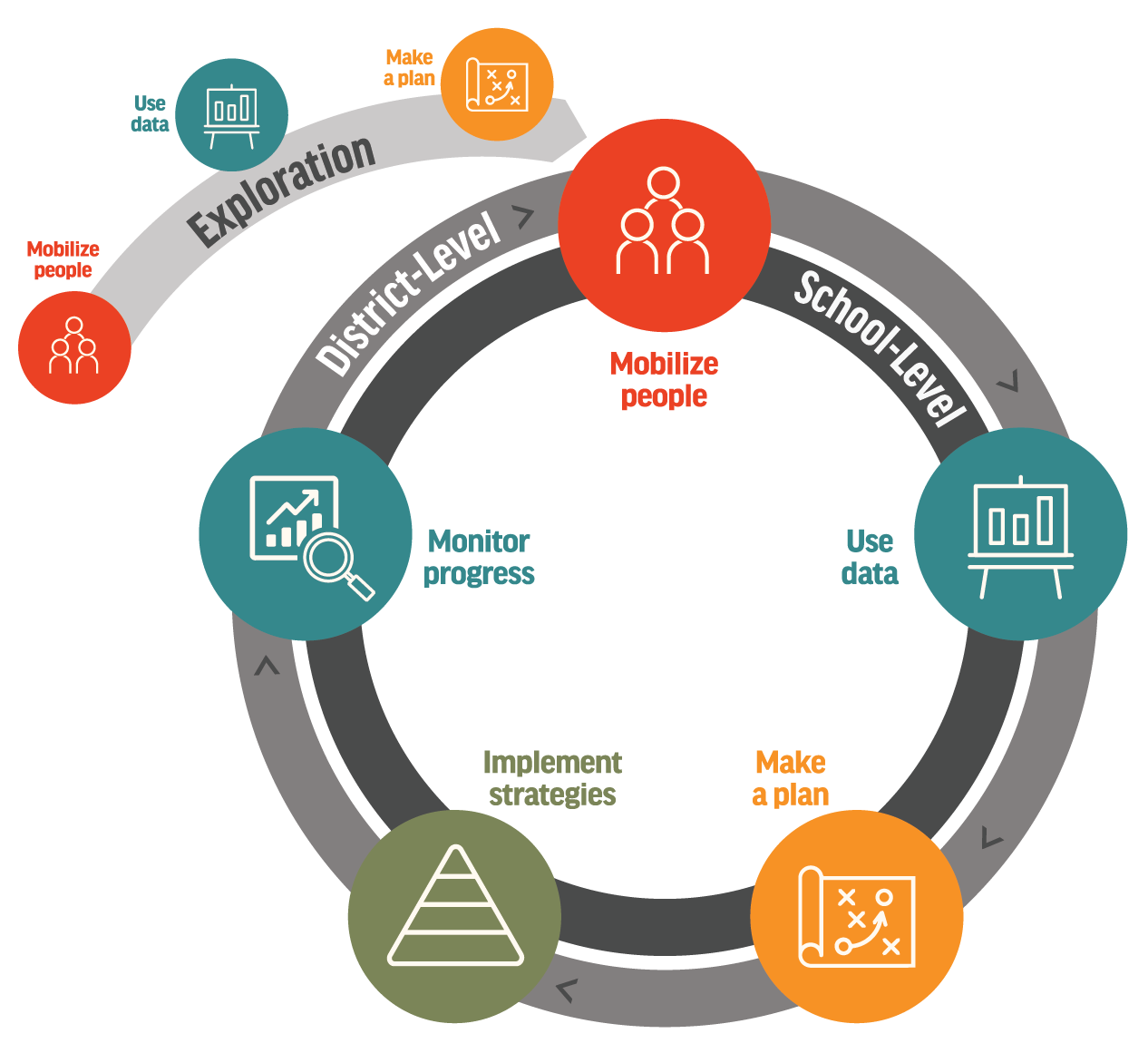NH’s Multi-Tiered System of Supports for Behavioral Health and Wellness (MTSS-B) framework is a comprehensive system of social, emotional, and behavioral supports to promote student wellness and improve engagement in learning. Based on the Interconnected Systems Framework (ISF), MTSS-B blends research-based school behavioral health and wellness practices with a tiered prevention framework.
This video offers a general overview of the MTSS-B framework and the five stages of its quality improvement process: mobilizing people, using data, action planning, implementing strategies, and monitoring progress.
Student and school wellness is an articulated district priority. Social skill building and mental health literacy are integrated throughout school culture, including schoolwide curricula and classroom management, as well as interventions for those with higher needs.
School, mental health, community, and family partners collaboratively develop an intentional, integrated approach to choosing and implementing evidence-based interventions to support student behavioral health needs.
Supports are delivered across three tiers: Tier 1 schoolwide/universal approaches for all students, Tier 2 targeted supports for at-risk students, and Tier 3 individualized services for the highest-need students.
MTSS-B implementation is monitored by ongoing measurement of: (1) reach – the who, what, where, and when of practice delivery; (2) fidelity – the degree to which the framework is implemented in a way that is faithful to the guiding model; and (3) outcomes – at both the individual student and school levels.
MTSS-B relies on the development of collaborative, multi-sector teams at all levels. An executive-level Exploration Team first determines need and potential fit of MTSS-B. Then, an expanded District-Community Leadership Team sets priorities, action plans, and secures resources for implementation. School-based tiered teams oversee implementation of MTSS-B practices, using data to select, improve, implement, and evaluate the systems that serve students’ behavioral health and wellness needs.
The use of data to inform action planning and progress monitoring is an ongoing process throughout implementation and maintenance of your MTSS-B system. Community, district, and school data help to initially identify needs and gaps in services; fidelity data provide a blueprint and reflect the quality of implementation; and reach and outcome data provide feedback on the scope and impact of your efforts.
After reviewing relevant community risk/protective factors, MTSS-B fidelity scores, and local district/school data sources, the District-Community Leadership Team articulates district-wide MTSS-B priorities and goals, with associated action plans and progress monitoring metrics. These plans guide school-level action plans and implementation, and all are revised regularly to support ongoing learning and adjustment.

Action plans guide implementation of MTSS-B strategies, including professional development and coaching; comprehensive social-emotional screening; Tier 1 and Advanced Tier (2/3) procedures; and facilitated referral pathways to community mental health. Teams use a structured, collaborative, and data-driven process to select EBPs that support student outcomes that are aligned across three tiers: Tier 1 universal supports for all; Tier 2 targeted services for at-risk students; and Tier 3 individual interventions for those with the highest need.
Implementation of the overarching MTSS-B framework and individual evidence-based practices are measured for (1) reach - the scope of support/service delivery; (2) fidelity – the degree to which the framework and specific interventions are delivered as the guiding model intended; and (3) student outcomes – at the whole-school (e.g., school climate, schoolwide office discipline referral rates) and individual student (e.g., behavior, academic engagement) levels.
Assess the match between local district-community need and the MTSS-B framework’s values, core features, and strategies, including an evaluation of current systems, practices, and resources to ensure MTSS-B fit and feasibility within your school district-community context
A District-Community Leadership Team with representation from district/school and partnering community youth & family-serving agencies guides implementation of district-wide MTSS-B priorities, goals, structures, and systems needed to support an integrated behavioral health service delivery model across schools
Install MTSS-B systems and structures at the school level, guided by district-wide goals including teaming across tiers, screening procedures, data-based decision-making protocols, implementation of evidence-based practices, ongoing coaching, performance feedback, and progress monitoring
All information posted on this website is for educational and informational purposes only and is not intended as a substitute for professional or legal advice. Should you decide to act upon any information on this website, you do so at your own risk.